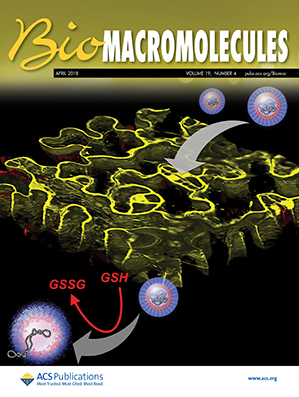结构工程化的so2释放聚合物纳米组件具有广谱抗菌活性。
IF 5.4
2区 化学
Q1 BIOCHEMISTRY & MOLECULAR BIOLOGY
引用次数: 0
摘要
阳离子抗菌剂被广泛认为是通过其膜破坏特性来对抗微生物感染。最近,二氧化硫(SO2)气体疗法已成为一种有前途的替代治疗疾病,包括细菌感染。然而,目前的系统通常只针对特定的细菌菌株。在这里,我们提出了两亲性交替共聚物DAPx (x = 1,2,3),包含阳离子残基和硫醇响应的二氧化硫释放部分。在水环境中,DAPx共聚物自组装成胶束纳米组件(DAPxNp),向外暴露亲水性阳离子残基,并在核心内封装疏水性二氧化硫释放部分,从而在谷胱甘肽(GSH)存在下实现二氧化硫的控制和持续释放。体外实验表明,dap2np具有良好的生物相容性,对革兰氏阳性菌(枯草芽孢杆菌、金黄色葡萄球菌)和革兰氏阴性菌(大肠杆菌、铜绿假单胞菌)均具有广谱抗菌活性。机理研究证实细菌的根除通过膜破坏和活性氧的产生。这项研究强调了释放二氧化硫的阳离子聚合物在抵抗细菌感染方面的显着功效。本文章由计算机程序翻译,如有差异,请以英文原文为准。
Structurally Engineered SO2–Releasing Polymeric Nanoassembly for Broad-Spectrum Antibacterial Activity
Cationic antimicrobial agents are widely recognized for combating microbial infections through their membrane–disruptive properties. Recently, sulfur dioxide (SO2) gas therapy has emerged as a promising alternative for treating diseases, including bacterial infections. However, current systems often target only specific bacterial strains. Herein, we present amphiphilic alternating copolymers, DAPx (x = 1, 2, 3), incorporating cationic residues and thiol-responsive SO2-releasing moieties. In aqueous environments, DAPx copolymers self-assemble into micellar nanoassemblies (DAPxNp), exposing hydrophilic cationic residues outward and encapsulating hydrophobic SO2-releasing moieties within the core to enable controlled and sustained release of SO2 in the presence of glutathione (GSH). In vitro studies reveal excellent biocompatibility of DAP2 Np with broad-spectrum antibacterial activity against both Gram-positive (Bacillus subtilis, Staphylococcus aureus) and Gram-negative (Escherichia coli, Pseudomonas aeruginosa) bacteria. Mechanistic investigations confirm bacterial eradication via membrane disruption and reactive oxygen species generation. This study underscores the remarkable efficacy of SO2-releasing cationic polymers in resisting bacterial infections.
- Download: Download high-res image (174KB)
- Download: Download full-size image
求助全文
通过发布文献求助,成功后即可免费获取论文全文。
去求助
来源期刊

Biomacromolecules
化学-高分子科学
CiteScore
10.60
自引率
4.80%
发文量
417
审稿时长
1.6 months
期刊介绍:
Biomacromolecules is a leading forum for the dissemination of cutting-edge research at the interface of polymer science and biology. Submissions to Biomacromolecules should contain strong elements of innovation in terms of macromolecular design, synthesis and characterization, or in the application of polymer materials to biology and medicine.
Topics covered by Biomacromolecules include, but are not exclusively limited to: sustainable polymers, polymers based on natural and renewable resources, degradable polymers, polymer conjugates, polymeric drugs, polymers in biocatalysis, biomacromolecular assembly, biomimetic polymers, polymer-biomineral hybrids, biomimetic-polymer processing, polymer recycling, bioactive polymer surfaces, original polymer design for biomedical applications such as immunotherapy, drug delivery, gene delivery, antimicrobial applications, diagnostic imaging and biosensing, polymers in tissue engineering and regenerative medicine, polymeric scaffolds and hydrogels for cell culture and delivery.
 求助内容:
求助内容: 应助结果提醒方式:
应助结果提醒方式:


